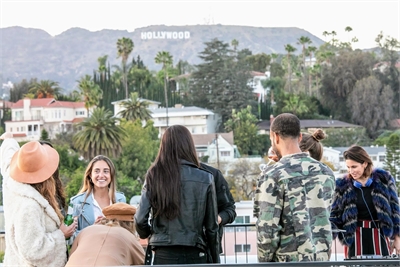No video provided.
Hollywood Facelift: The Newly Restored Villa Carlotta
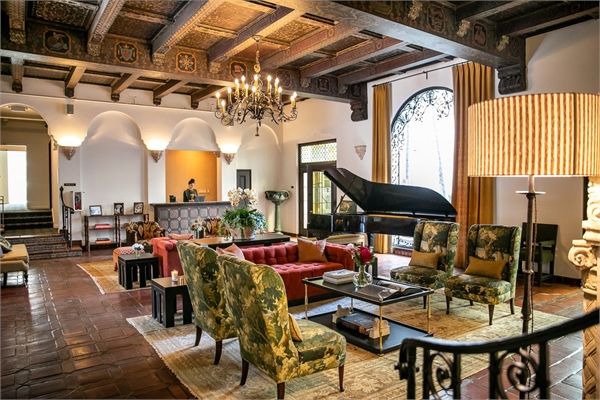
Nestled in the heart of Franklin Village rests the Villa Carlotta, a majestic piece of Hollywood history that only a few years ago was a mere shadow of its former self. Built in 1926, the Villa Carlotta began as only a Hollywood story could. Legendary silent film producer and “Father of the Western” Thomas Ince mysteriously died following a party aboard newspaper mogul William Randolph Hearst’s USS Oneida. Rumors circulated attributing Ince’s death to murder by the hands of Hearst himself. Two years later, Hearst helped finance construction of the Villa Carlotta, owned by Ince’s widow, Elinor, and home to Hollywood’s creatives. From Marion Davies and Montgomery Clift to renowned gossip columnist Louella Parsons and the Doors front-man Jim Morrison in the 1960’s, the Villa Carlotta evolved into a community that attracted countless people from the entertainment industry. Decades later, CGI purchased the Villa Carlotta and began the challenging task of restoring the nearly century old building. Over the span of 2 years, the Old Hollywood gem, with a history as rich in creativity and diversity as the very city it inhabits, was restored to its former glory.
CGI co- founders Adrian Goldstein and Gidi Cohen were responsible for the decision to begin renovations on the Villa Carlotta. Cohen’s travels to the north of Italy sparked his interest. “Spending time at the Villa Carlotta in Lake Como had completely inspired me, then a year later the opportunity came up for Villa Carlotta LA,” Cohen explains. “I was drawn to it. I knew this amazing treasure needed to be polished. It had such great bones. I assembled the dream team, and we got to work.”
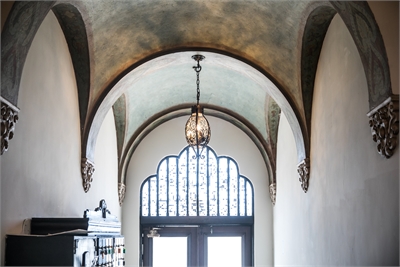 For Goldstein, it was at love at first sight. “We immediately fell in love with the building when we saw it,” Goldstein explains. “It’s got a lot of architectural charm. I don’t think we had any clue what we were undertaking. The previous owner had not renewed the lease and basically ran out of cash and resources to repair and renovate the building. As we went from unit to unit, it was musty, old, and dirty. It had cockroaches running through the walls. The plumbing wasn’t working. The heating wasn’t working.” Despite its flaws, Goldstein and Cohen still saw its potential. “We looked at this and said, ‘Wow, we can fix that! We could restore this beautiful building and bring it back to the past that it had.’ We hired artists, designers, and architects to assist us.”
For Goldstein, it was at love at first sight. “We immediately fell in love with the building when we saw it,” Goldstein explains. “It’s got a lot of architectural charm. I don’t think we had any clue what we were undertaking. The previous owner had not renewed the lease and basically ran out of cash and resources to repair and renovate the building. As we went from unit to unit, it was musty, old, and dirty. It had cockroaches running through the walls. The plumbing wasn’t working. The heating wasn’t working.” Despite its flaws, Goldstein and Cohen still saw its potential. “We looked at this and said, ‘Wow, we can fix that! We could restore this beautiful building and bring it back to the past that it had.’ We hired artists, designers, and architects to assist us.”
The few remaining tentants were informed they had to relocate, and while most accepted the generous buy-out, others were more hesitant to accept change. Former Resident Manager Don Paul, who lived at the Villa Carlotta for 30 years, was hired on as a historical consultant. “You’ve got to be able to change and move with the times.” Paul explains. “This building needed restoration. The rewiring, foundation, plumbing- all the work they did was wonderful. Their attention to keeping things original is to be admired.”
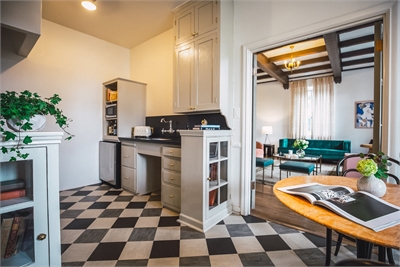 Preservation Architect with the Los Angeles Department of City Planning Lambert Giessinger was responsible for reviewing and approving the plans for the Villa Carlotta. “The staff’s role was to work with the owner and their team to ensure the project design met the preservation standards required by the Cultural Heritage ordinance,” Giessinger explains. “The Villa Carlotta is an iconic cultural monument that had fallen into disrepair. The rehabilitation project was important to reverse the years of neglect.”
Preservation Architect with the Los Angeles Department of City Planning Lambert Giessinger was responsible for reviewing and approving the plans for the Villa Carlotta. “The staff’s role was to work with the owner and their team to ensure the project design met the preservation standards required by the Cultural Heritage ordinance,” Giessinger explains. “The Villa Carlotta is an iconic cultural monument that had fallen into disrepair. The rehabilitation project was important to reverse the years of neglect.”
Repairing decades of damage was an undertaking filled with challenges but worth the effort. First- priority was given to replacing the mechanical, electrical, and plumbing systems. Everything from the faucets and drains, to tubs and toilets were either restored or replaced. “What originally looked like a cosmetic fix ended up being in some places a total gut and repair,” Goldstein explains. “We got into the guts of the building to bring it up to modern day standards. Once we completed that, we set to doing this renovation. We hired people to strip paint off all the cabinetry. Where it was really badly damaged, we brought carpenters to build us matching cabinetry. We brought in a mold that replicates the molding in the building that we have on the doors. Where some of the door molding was missing, we milled it ourselves. We sanded and refinished all the floors. We took a photograph from the 1920’s, which had some carpeting, to a mill. They milled a carpet with this design and brought the colors from the ceiling in the lobby into the carpet. When the building was originally built, the colors on the ceiling were more vibrant. After nearly a hundred years, the paint has become more muted. Today we have oranges, greens, yellows, and blues that are very subtle. It has the patina of an aged look.”
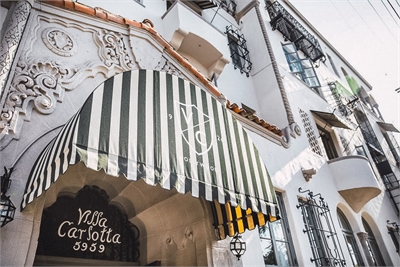 Just as much care and attention was given to the outside of the building. “When the building was originally built, it had awnings and curtains on the outside. You couldn’t do curtains on the outside of the building today because of fire hazards, but we wanted to restore the awnings. The company that put them on in the 1920’s is called the Van Nuys Awning Company, and they’re still in business in the same location. We used them to create awnings for the exterior. We added some lighting, which they didn’t have in the 1920’s. It showcases the exterior really nicely at night.”
Just as much care and attention was given to the outside of the building. “When the building was originally built, it had awnings and curtains on the outside. You couldn’t do curtains on the outside of the building today because of fire hazards, but we wanted to restore the awnings. The company that put them on in the 1920’s is called the Van Nuys Awning Company, and they’re still in business in the same location. We used them to create awnings for the exterior. We added some lighting, which they didn’t have in the 1920’s. It showcases the exterior really nicely at night.”
Christos Prevezanos, Principal and Founder of Studio Preveza, was the designer behind specially created furniture made to fit the style of the 1920’s. Prevezanos explains, “The most challenging aspect was to be true to the building and honoring its heritage without making it feel too nostalgic and Disney-fied. The Villa Carlotta has such a strong personality, and it was nice to have that foundation to build upon.”
Two years after the start of its remarkable transformation, the Villa Carlotta offers a rare glimpse into the glamorous past of Old Hollywood, offering its residents a trip back in time with its architecture, design, smells, and sounds. From the hand- painted details to the vintage artwork in each room, every square inch is a testament to the work that went into a restoration that has honored its history and beauty. Building Manager Brian McGrory is responsible for making guests feel at home. “I want residents to feel a part of something. This is not just a regular service apartment building; it’s an experience. I want them to feel like this is their home away from home. It’s nice that they’re here for a while; we get to know them, have a coffee with them in the morning, and maybe a glass of wine at night.”
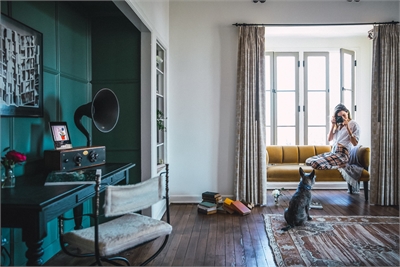 With years of experience in the hospitality industry, McGrory explains the significance of places like the Villa Carlotta. “People genuinely connect with this place. It’s a unique building factually drenched with Hollywood history. There was a time before when developers would tear down buildings because it was easier for them to build a high rise. To have this restored and have this on your doorstep enhances the community. It brings so much culture and history and creates beauty, depth and layers. Being a member of the community here, to have this is phenomenal.”
With years of experience in the hospitality industry, McGrory explains the significance of places like the Villa Carlotta. “People genuinely connect with this place. It’s a unique building factually drenched with Hollywood history. There was a time before when developers would tear down buildings because it was easier for them to build a high rise. To have this restored and have this on your doorstep enhances the community. It brings so much culture and history and creates beauty, depth and layers. Being a member of the community here, to have this is phenomenal.”
On October 19, 2018, the California Preservation Foundation will be rewarding the Villa Carlotta with the prestigious 2018 Preservation Design Award. Goldstein is honored that efforts towards restoring such a vital part of California history has not gone unnoticed. “It’s really special. To be recognized by this organization is beyond our dreams. We’re very proud. It’s really been a labor of love. For some people, you can step back in time and feel a connection to Hollywood’s past. We have artists and actors from all over the world that have stayed with us, and the story continues.”
